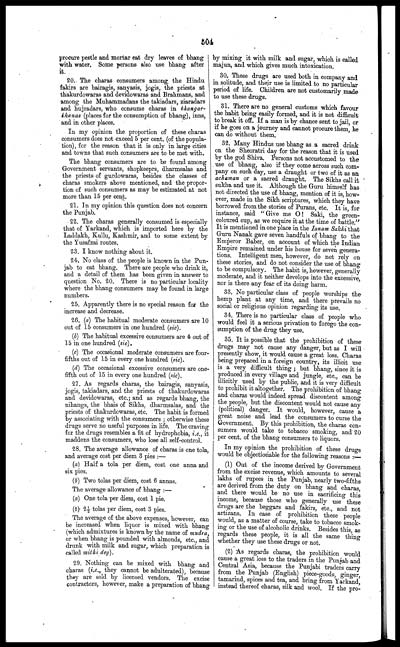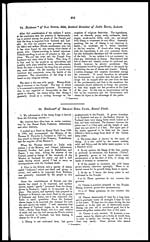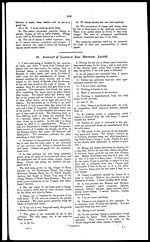Medicine - Drugs > Report of the Indian Hemp Drugs Commission, 1894-1895 > Volume V
(524) Page 504
Download files
Individual page:
Thumbnail gallery: Grid view | List view

504
procure pestle and mortar eat dry leaves of bhang
with water. Some persons also use bhang after
it.
20. The charas consumers among the Hindu
fakirs are bairagis, sanyasis, jogis, the priests at
thakurdowaras and devidowaras and Brahmans, and
among the Muhammadans the takiadars, ziaradars
and hujradars, who consume charas in bhangar-
khanas (places for the consumption of bhang), inns,
and in other places.
In my opinion the proportion of these charas
consumers does not exceed 5 per cent. (of the popula-
tion), for the reason that it is only in large cities
and towns that such consumers are to be met with.
The bhang consumers are to be found among
Government servants, shopkeeprs, dharmsalas and
the priests of gurdowaras, besides the classes of
charas smokers above mentioned, and the propor-
tion of such consumers as may be estimated at not
more than 15 per cent.
21. In my opinion this question does not concern
the Punjab.
22. The charas generally consumed is especially
that of Yarkand, which is imported here by the
Laddakh, Kullu, Kashmir, and to some extent by
the Yusafzai routes.
23. I know nothing about it.
24. No class of the people is known in the Pun-
jab to eat bhang. There are people who drink it,
and a detail of them has been given in answer to
question No. 20. There is no particular locality
where the bhang consumers may be found in large
numbers.
25. Apparently there is no special reason for the
increase and decrease.
26. (a) The habitual moderate consumers are 10
out of 15 consumers in one hundred (sic).
(b) The habitual excessive consumers are 4 out of
15 in one hundred (sic).
(c) The occasional moderate consumers are four-
fifths out of 15 in every one hundred (sic).
(d) The occasional excessive consumers are one-
fifth out of 15 in every one hundred (sic).
27. As regards charas, the bairagis, sanyasis,
jogis, takiadars, and the priests of thakurdowaras
and devidowaras, etc.; and as regards bhang, the
nihangs, the bhais of Sikhs, dharmsalas, and the
priests of thakurdowaras, etc. The habit is formed
by associating with the consumers ; otherwise these
drugs serve no useful purposes in life. The craving
for the drugs resembles a fit of hydrophobia, i.e., it
maddens the consumers, who lose all self-control.
28. The average allowance of charas is one tola,
and average cost per diem 3 pies :—
(a) Half a tola per diem, cost one anna and
six pies.
(b) Two tolas per diem, cost 6 annas.
The average allowance of bhang :—
(a) One tola per diem, cost 1 pie.
(b) 2½ tolas per diem, cost 3 pies.
The average of the above expenses, however, can
be increased when liquor is mixed with bhang
(which admixtures is known by the name of mudra,
or when bhang is pounded with almonds, etc., and
drunk with milk and sugar, which preparation is
called mithi deg).
29. Nothing can be mixed with bhang and
chavas (i.e., they cannot be adulterated), because
they are sold by licensed vendors. The excise
contractors, however, make a preparation of bhang
by mixing it with milk and sugar, which is called
majun, and which gives much intoxication.
30. These drugs are used both in company and
in solitude, and their use is limited to no particular
period of life. Children are not customarily made
to use these drugs.
31. There are no general customs which favour
the habit being easily formed, and it is not difficult
to break it off. If a man is by chance sent to jail, or
if he goes on a journey and cannot procure them, he
can do without them.
32. Many Hindus use bhang as a sacred drink
on the Sheoratri day for the reason that it is used
by the god Shiva. Persons not accustomed to the
use of bhang, also if they come across such com-
pany on such day, use a draught or two of it as an
achaman or a sacred draught. The Sikhs call it
sukha and use it. Although the Guru himself has
not directed the use of bhang, mention of it is, how-
ever, made in the Sikh scriptures, which they have
borrowed from the stories of Purans, etc. It is, for
instance, said " Give me O! Saki, the green-
coloured cup, as we require it at the time of battle."
It is mentioned in one place in the Ianam Sakhi that
Guru Nanak gave seven handfuls of bhang to the
Emperor Baber, on account of which the Indian
Empire remained under his house for seven genera-
tions. Intelligent men, however, do not rely on
these stories, and do not consider the use of bhang
to be compulsory. The habit is, however, generally
moderate, and it neither develops into the excessive,
nor is there any fear of its doing harm.
33. No particular class of people worships the
hemp plant at any time, and there prevails no
social or religious opinion regarding its use.
34. There is no particular class of people who
would feel it a serious privation to forego the con-
sumption of the drug they use.
35. It is possible that the prohibition of these
drugs may not cause any danger, but as I will
presently show, it would cause a great loss. Charas
being prepared in a foreign country, its illicit use
is a very difficult thing ; but bhang, since it is
produced in every village and jungle, etc., can be
illicitly used by the public, and it is very difficult
to prohibit it altogether. The prohibition of bhang
and charas would indeed spread discontent among
the people, but the discontent would not cause any
(political) danger. It would, however, cause a
great noise and lead the consumers to curse the
Government. By this prohibition, the charas con-
sumers would take to tobacco smoking, and 20
per cent. of the bhang consumers to liquors.
In my opinion the prohibition of these drugs
would be objectionable for the following reasons :—
(1) Out of the income derived by Government
from the excise revenue, which amounts to several
lakhs of rupees in the Punjab, nearly two-fifths
are derived from the duty on bhang and charas,
and there would be no use in sacrificing this
income, because those who generally use these
drugs are the beggars and fakirs, etc., and not
artizans. In case of prohibition these people
would, as a matter of course, take to tobacco smok-
ing or the use of alcoholic drinks. Besides this, as
regards these people, it is all the same thing
whether they use these drugs or not.
(2) As regards charas, the prohibition would
cause a great loss to the traders in the Punjab and
Central Asia, because the Punjabi traders carry
from the Punjab (English) piece-goods, ginger,
tamarind, spices and tea, and bring from Yarkand,
instead thereof charas, silk and wool. If the pro-
Set display mode to: Large image | Zoom image | Transcription
Images and transcriptions on this page, including medium image downloads, may be used under the Creative Commons Attribution 4.0 International Licence unless otherwise stated. ![]()
| India Papers > Medicine - Drugs > Report of the Indian Hemp Drugs Commission, 1894-1895 > Volume V > (524) Page 504 |
|---|
| Permanent URL | https://digital.nls.uk/75122420 |
|---|
| Description | Volume 5: Evidence of witnesses from North-Western Provinces and Oudh and Punjab. Answers from witnesses in North-Western Provinces, Oudh and Punjab about cultivation and growth of hemp, preparation or manufacture, trade, consumption or use, effects, administration - taxation and control. |
|---|---|
| Attribution and copyright: |
|




